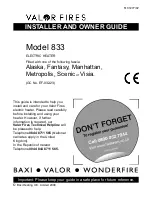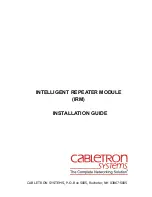
M-Series Technical Manual
33
Cambridge Air Solutions
• Disconnect push ons at Input Signal terminals #5 & #6.
• Connect test leads with alligator clips from a current/voltage
signal generator to terminals #5 & #6.
• This will drive the modulating valve to full open and keep the
heater in continuous high fire.
c. If the ambient temperature is at or above
the Entering Air Thermostat (EAT) setpoint
on the multi-functional PC board, then note
the setpoint position and set the EAT to its
highest setting (see page 94). If the ambient
temperature exceeds its highest setting, remove
the set point jumper and rotate 90˚ for the
bypass mode.
d. Remove the 1/8" NPT plug from the manual
shut-off valve located just prior to the burner
and connect a manometer for the purpose of
measuring the manifold pressure.
e. Refer to the heater nameplate for the Manifold
Differential Pressure (MDP) (
inch
WC) for
which the heater was specified.
Record the Nameplate Manifold Differential
Pressure
f. Turn the disconnect switch on.
g. Turn the blower service switch to the
“
LOCAL
”
position. The blower motor will
start. Monitor the pressure reading on the
manometer. Record the Manifold Static Pressure
(Blower Only).
h. Using the formula below, calculate the required
manifold pressure:
Nameplate Manifold Differential Pressure
___________
inch
WC
+ Manifold Static Pressure (Blower Only)
___________
inch
WC
= Calculated Manifold Pressure
___________
inch
WC
IMPORTANT
The high limit may trip on warm days. If this occurs
allow the high limit to cool by leaving the blower only
on for 3-5 minutes. Turn the blower and burner switches
to the "OFF" position. Access the high limit and
manually reset. Replace access panels. Turn the blower
and burner switches to the "LOCAL" position.
i. Turn the burner service switch to the
“
LOCAL
”
position. After a delay for pre-
purge and igniter warm-up, the burner will
light.
j. Observe the manometer reading and compare
to the Calculated Manifold Pressure above. If
the manifold pressure reading does not equal this
value, adjust the manifold pressure regulator
until the proper manifold pressure is obtained.
See page 76 for gas train drawings.
IMPORTANT
The pressure drop across the burner profile damper that
was adjusted in Step 5 (page 31) must not fall below
0.51 inches WC for natural gas heaters without filters
or 0.55 inches WC for natural gas heaters with a filter
section or filters in the rainhood. The pressure drop
must not fall below 0.75 inches WC for LP gas heaters
without filters or 0.79 inches WC for LP gas heaters with
a filter section or filters in the rainhood. If the pressure
drop is below these values the low airflow switch will
shutoff power to the burner. This is an indication of low
airflow or burner overfiring. To correct this condition,
either adjust the manifold pressure regulator to reduce
the manifold pressure or increase the blower speed,
provided the motor full load amps are not exceeded.
k. Turn the blower and burner service switches
to the
“
OFF
”
position, remove the manometer
from the manual shut-off valve, re-install the
1/8" NPT plug.
8. GAS VALVE LEAK CHECK
All heaters should be evaluated for the gas
tightness of the gas valve seat. Heaters with
separate redundant valves are equipped with a
leak test facility to assist in checking this seal. A
momentary switch and a gas port for measuring
pressure between valves are provided as the leak
test hardware (page 76). Refer to the Individual
Component Description Section (page 91) for
more information regarding the leak test switch.
The procedures for the gas valve leak check are as
follows:
a.
Connect a 0 to 10 inches water column
(
inch
WC) manometer to the 1/8" NPT
tapped fitting on the manual shut-off
valve located just prior to the burner for
the purpose of monitoring an increase in
pressure. Verify that the manometer is
properly zeroed.
b.1. On single redundant valve applications
(heaters rated less than 400,000 Btu/
















































